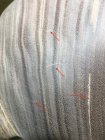I see more and more finished cracked work showing up on the internet. One turning Facebook page has multiple cracked pieces appearing everyday. Turners even asking for advice on using wood that is full of cracks. Are people really selling this work? Is it in vogue now? To me, it's like wood got real hard to find all of a sudden. For comparison, you'd never find a piece of cracked ceramic or glass at a show. Not unless a customer dropped it!
-
Beware of Counterfeit Woodturning Tools (click here for details) -
Johnathan Silwones is starting a new AAW chapter, Southern Alleghenies Woodturners, in Johnstown, PA. (click here for details) -
Congratulations to Peter Jacobson for "Red Winged Burl Bowl" being selected as Turning of the Week for April 29, 2024 (click here for details) -
Welcome new registering member. Your username must be your real First and Last name (for example: John Doe). "Screen names" and "handles" are not allowed and your registration will be deleted if you don't use your real name. Also, do not use all caps nor all lower case.
You are using an out of date browser. It may not display this or other websites correctly.
You should upgrade or use an alternative browser.
You should upgrade or use an alternative browser.
Is cracked work the best new thing?
- Thread starter Richard Coers
- Start date
odie
TOTW Team
- Joined
- Dec 22, 2006
- Messages
- 7,121
- Likes
- 9,877
I guess it's all in how it's presented, Richard. If a cracked turning is thought to be "desirable", then someone will buy it! I wish I could speak for the "buying public", but most cracks look like failures to me. There is an exception to this, when it can look "naturally occurring", as in some burls, or with certain voids and bark inclusions......but, most cracks just look like failures, and it's difficult to hide that. Some turners use pewas and other attempts to look repaired, such as the "sewn" look, but I've never been a fan of these things......they still look like failures with attempts to make repairs.
If you're seeing a lot of cracks in other people's bowls, I suspect it's because many turners refuse to accept defeat.......and, try to pass off repairs as something that looks passable, or even desirable, even though it's obviously something that was never intended in the first place.
-----odie-----
If you're seeing a lot of cracks in other people's bowls, I suspect it's because many turners refuse to accept defeat.......and, try to pass off repairs as something that looks passable, or even desirable, even though it's obviously something that was never intended in the first place.
-----odie-----
Last edited:
Martin Groneng
Dances the Gouge Jig
Right on odie and Richard. Most "true" turners would immediately recognise a crack and wonder. That's why wood for burning is often cracked!
I think it depends on what it is the turner/artist is trying to create. I use a lot of burl in some of my decorative turning I purposely leave them "distressed" to help give them an aged appearance of. (See attached pictures) I will also use turquoise to fill some cracks in turnings that have a functional nature. However, on some pieces I agree that any crack in the turning is a real distraction and also brings into account future structural problems.
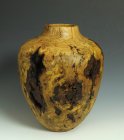
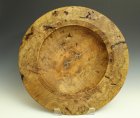
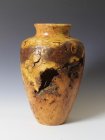



john lucas
AAW Forum Expert
It all depends on the wood and whether or not you want to save it. New turners have trouble finding wood that isn't cracked and spend a lot of time trying to turn it so saving it if possible is what they do. that being said I turned a walnut piece the other day that had a crack. I didn't think it went that deep and filled it with dark colored epoxy. Well it did go deep, all the way through after I turned the bowl. I kept it and someday will probably sell it. I don't like it but every non turner I have shown it too loves it. I still think you should not turn pieces with cracks other than Art pieces like Steve posted, but sometimes you just gotta.
- Joined
- Jan 27, 2005
- Messages
- 12,900
- Likes
- 5,188
- Location
- Dalworthington Gardens, TX
- Website
- pbase.com
If it's cracked before putting it on the lathe then the intent was to make it part of the design. However, if it cracks during or after turning the piece then that's a different matter. It might become firewood or a design opportunity.  "Design opportunities" aren't necessarily bad because they might be great learning opportunities even if the piece never makes it out of the shop intact.
"Design opportunities" aren't necessarily bad because they might be great learning opportunities even if the piece never makes it out of the shop intact.
FWIW, here is my "design opportunity" story:
It didn't occur to me to take a "before" picture. If it weren't for the "design opportunity" pictured below I probably never would have decided to get involved in basket Illusions. IIRC, the wood is from a live oak rootball. When live oak is green and wet it turns like butter. After it dries, it's like a brick. This was many years ago and I was about to learn another lesson on turning hard dry wood. I had a "really spectacular" catch, the bowl flew off the lathe and bounced around the shop and about a fourth of it was missing. I found the missing part and somewhat surprisingly the two parts fit together perfectly except for one tiny chip. Being a very white wood the glue line could still be seen. Mrs B said to toss it, but being stubborn and stupid I refused to give up. A few months earlier I attended a David Nittmann demo at SWAT and was wowed by his work so I decided to see what I could do. I had never done anything so mind numbing and tedious. When I finished, the results were only so-so and I swore that I would never do that again.

A number of years later I attended a Jim Adkins demo at SWAT and decided that I just had to try his style of basket illusions. So much for swearing that I would never do that again.
FWIW, here is my "design opportunity" story:
It didn't occur to me to take a "before" picture. If it weren't for the "design opportunity" pictured below I probably never would have decided to get involved in basket Illusions. IIRC, the wood is from a live oak rootball. When live oak is green and wet it turns like butter. After it dries, it's like a brick. This was many years ago and I was about to learn another lesson on turning hard dry wood. I had a "really spectacular" catch, the bowl flew off the lathe and bounced around the shop and about a fourth of it was missing. I found the missing part and somewhat surprisingly the two parts fit together perfectly except for one tiny chip. Being a very white wood the glue line could still be seen. Mrs B said to toss it, but being stubborn and stupid I refused to give up. A few months earlier I attended a David Nittmann demo at SWAT and was wowed by his work so I decided to see what I could do. I had never done anything so mind numbing and tedious. When I finished, the results were only so-so and I swore that I would never do that again.
A number of years later I attended a Jim Adkins demo at SWAT and decided that I just had to try his style of basket illusions. So much for swearing that I would never do that again.
- Joined
- Apr 27, 2004
- Messages
- 8,647
- Likes
- 4,995
- Location
- Lakeland, Florida
- Website
- www.hockenberywoodturning.com
Pre existing cracks often add organic elements to the work. They certainly can add an illusion of age to a piece.
Many years ago I had a bad idea for a series of hollow forms that I left a little bit thick in the side walls. Heated an oven to 400 put the wet hollow form in the oven turned it off. This forced cracks and I dyed the forms black. I later referred to it as my ugly black pot phase.
I have 15” natural edge oak bowl with an unseen crack centered in the bottom. I knew the log had pith cracks visible. I misjudged how deep it went and it opened up a tiny bit in the dried bowl. This bowl has some sentimental value to the trees owner. I think it will look great with a thin back line.
The hollow form below i sought out a blank with a crack in it to use for the frog crawling out..

Many years ago I had a bad idea for a series of hollow forms that I left a little bit thick in the side walls. Heated an oven to 400 put the wet hollow form in the oven turned it off. This forced cracks and I dyed the forms black. I later referred to it as my ugly black pot phase.
I have 15” natural edge oak bowl with an unseen crack centered in the bottom. I knew the log had pith cracks visible. I misjudged how deep it went and it opened up a tiny bit in the dried bowl. This bowl has some sentimental value to the trees owner. I think it will look great with a thin back line.
The hollow form below i sought out a blank with a crack in it to use for the frog crawling out..

Last edited:
A buddy was by with his wife a few weeks ago, and he asked about my work shop. So I gave him the tour. He saw the shelves of turning blanks stacked and sorted by size and species and then said he looked at some turning sites and saw a lot of work with big ugly knots in them. He asked if those folks couldn't afford a clear piece of wood. MPO is that a series of knots can make a piece very interesting and a challenge to turn, but a single knot would cause me to pitch the blank into the firewood pile. I don't turn many bowls. A few months back I tried to turn one of sassafras and got a half hour into it and discovered a crack. that ran part way around the piece following one particular ring. I immediately ceased turning the piece and never did finish it. Yet some folks post picture of work with noticeable but slight cracks. A big void kind of makes a hollow form vessel look like a cosplay model of a destroyed space fantasy world.. Now that can indeed be interesting, but like an elephant is also interesting, I wonder about who would want it. Maybe the perception of such pieces is what separates the true artist, would be artist and the utilitarian turner. . .
For me it's kind of a judgement each time that I run into a knot, crack or void. Sometimes I'll put it on the firewood pile and then go back later that day and bring it back into the shop for some kind of remedial work. Some pieces have made several trips to and from the firewood pile.
I wasn't particularly talking about knots or voids. I was thinking out loud about shrinkage cracks. Cracks in clear wood. I have filled a few knots in my day, but with a subtle dark color that makes it look like a knot. Not make it a stronger show than the form.
Was reading this thread and this bowl was in front of me on a coffee table, so I posted it and am including here. It is the other half of a maple crotch I turned a number of years ago and had a stress crack from when the tree hit the ground. I was second turning it for a charity silent auction in May when I discovered the crack and came up with another bowl as I did not want the crack showing in a piece people were bidding on. My wife suggested enlarging the crack and filling so I used a dental burr in my Dremmel and filled with epoxy / turquoise powder. Did not have time when I needed the bowl for the auction but completed soon after. The other half of it had a spectacular feather and I second turned it twelve days after putting in my kiln. This one is not bad and I am glad I took the time to follow my wife's suggestion. 11' in diameter by 3 1/2" high, finished with Watco Danish Oil, buffed and waxed with Conservators Microcrystalline Wax.

Last edited:
I had this piece of Bradford Pear sitting for a while and crack in the crotch enlarged. I turned just to see what it had and it was to good to discard so I embellished and left the crack as is. I know you may be talking about cracks that show up in drying but I could not pull one out right away and this shows saving a piece because of what it has in the wood. Feather is on the back but there are also two cracks showing in the front.

odie
TOTW Team
- Joined
- Dec 22, 2006
- Messages
- 7,121
- Likes
- 9,877
That one by Gerald Lawrence doesn't bother me, but I think some very picky people might take exception.......most won't though.
When I turned this cherry burl, I was very disappointed in the crack. I have it for sale, and I think probably someone who sees it as being "natural" will eventually buy it......maybe.....maybe not!
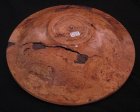

-----odie-----
When I turned this cherry burl, I was very disappointed in the crack. I have it for sale, and I think probably someone who sees it as being "natural" will eventually buy it......maybe.....maybe not!


-----odie-----
It’s all in the eye of the beholder. I look for wood with cracks for my blanks. When my work was to be featured in our local magazine, the editor picked pieces with cracks for the photo. He is a visual media expert with no woodturning background.
Attachments
It all depends on the crack, the wood and where it is. I made a few poplar bowls recently and had some cracks. Filled them with epoxy mixed with black dye then stained them with walnut stain. The cracks blended in fine.
I would sell them or give them away since I think they look good. It’s up to you what you think looks good.
I don’t get a ton of logs so I need to make the best with what I get.
I would sell them or give them away since I think they look good. It’s up to you what you think looks good.
I don’t get a ton of logs so I need to make the best with what I get.
That’s what Pewa are for, lolThat one by Gerald Lawrence doesn't bother me, but I think some very picky people might take exception.......most won't though.
When I turned this cherry burl, I was very disappointed in the crack. I have it for sale, and I think probably someone who sees it as being "natural" will eventually buy it......maybe.....maybe not!
View attachment 26230 View attachment 26231
-----odie-----
odie
TOTW Team
- Joined
- Dec 22, 2006
- Messages
- 7,121
- Likes
- 9,877
That’s what Pewa are for, lol
I do accept that pewas enhance structural stability.......I'm one who has a philosophy that isn't in agreement with some that it looks acceptable in all cases. It is, after-all......a repair......and not everyone is going to agree that repairs are on par with accepting natural cracks that are obviously Mother Nature created.
It's somewhere in the middle of a very controversial act.....
-----odie-----
- Joined
- Jan 27, 2005
- Messages
- 12,900
- Likes
- 5,188
- Location
- Dalworthington Gardens, TX
- Website
- pbase.com
Yep.....I do understand that, Emiliano!
I do accept that pewas enhance structural stability.......I'm one who has a philosophy that isn't in agreement with some that it looks acceptable in all cases. It is, after-all......a repair......and not everyone is going to agree that repairs are on par with accepting natural cracks that are obviously Mother Nature created.
It's somewhere in the middle of a very controversial act.....
-----odie-----
Putting pewas on calabash bowls in Hawaii is like putting gravy on biscuits in Texas ... you do it because it's ingrained in the culture, not because it withstands logical scrutiny. It's as much of an obligatory design element as the detail grooves that are your signature feature.
odie
TOTW Team
- Joined
- Dec 22, 2006
- Messages
- 7,121
- Likes
- 9,877
Putting pewas on calabash bowls in Hawaii is like putting gravy on biscuits in Texas ... you do it because it's ingrained in the culture, not because it withstands logical scrutiny. It's as much of an obligatory design element as the detail grooves that are your signature feature.
Absolutely true, Bill......All I intend to point out, is not everyone holds the same opinion about these things. Pewas might be cultural, but not everyone has the "ingrained" inclination to think of what is an obvious repair, as something that is a positive thing aesthetically. Some may consider pewas perfectly acceptable in the utilitarian sense.......but, when we attempt to make the leap from "utilitarian" to "artistic", there is a tendency for many observers to reject it on that level.
In my humble opinion, pewas can truly be an artistic statement, if there were no crack at all!
-----odie-----
Last edited:
- Joined
- Apr 27, 2004
- Messages
- 8,647
- Likes
- 4,995
- Location
- Lakeland, Florida
- Website
- www.hockenberywoodturning.com
One of the top artistic bowl turners in the world is Jerry Kermode.
He uses stitches - these start out as biscuit joinery with hardwood biscuits he makes. When the glue dries the walls are finish turned.
http://www.jerrykermode.com/artwork/
But look at the curves Jerry gets. Mastering curves is a never ending goal.
The curve makes the Calabash as well.
The Calabash are about curve and volume.
He uses stitches - these start out as biscuit joinery with hardwood biscuits he makes. When the glue dries the walls are finish turned.
http://www.jerrykermode.com/artwork/
But look at the curves Jerry gets. Mastering curves is a never ending goal.
The curve makes the Calabash as well.
The Calabash are about curve and volume.
- Joined
- Apr 27, 2004
- Messages
- 8,647
- Likes
- 4,995
- Location
- Lakeland, Florida
- Website
- www.hockenberywoodturning.com
Ok, I have a piece of walnut on the lathe right now. It started out at about 13" and is now down to 9'. I have a very few tight cracks and one I'll call a grain void. What would you guys do with this piece? Sanded to 400.
The crack that follows the growth ring is known as a ring shake or wind shake and is one of the most dangerous features in wood. Only air holds the wood together across the shake. The danger is the crack extending around the growth ring and you get two pieces of wood only one of which is attached to the lathe. Or you cut the wood that doesn’t have the ring shake away to the where it can hold the two parts together. Walnut seems to have ring shake smore often than most woods.
The ring shake may open up. CA might keep it from opening. If you have not hollowed the bowl-hollowing it could make it 2 pieces.
The other cracks are checks from drying. The wood coils not move so it checks to shrink. The wood should have been turned before it becan to check. These don’t appear to be a problem. They are unlikely to grow. And will,be hard to see with a wiping oil type finish like Waterlox or similar.
When I cut 1/2 logs for bowls I cut them 4” longer than the log thickness.
This give me 2” to throw away whe I cut the round. This usually gets any end checking is the endgrain is sealed and the bowls are roughed within a month or two.
Since you have turned past normal end checking. The log dried too much.
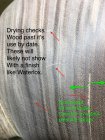
Last edited:
I really like Danish Oil as a finish for walnut. I would wet sand with some oil and 220 paper and it would likely fill those cracks. Really pops the grain and gives it a nice dark look than non penetrating finishes do not. Hand wipe across the grain and the cracks and let dry thoroughly, then buff.Ok, I have a piece of walnut on the lathe right now. It started out at about 13" and is now down to 9'. I have a very few tight cracks and one I'll call a grain void. What would you guys do with this piece? Sanded to 400.
View attachment 26250
Put a thinned coat of finish (aka sanding sealer) on it first, then apply thin and/or medium CA glue to each cracks as needed. Sand off the excess CA glue so it's only left in the cracks. Finally apply your finish.
Like Hockeneberry mentioned, be real careful with woods like walnut & cherry that have signs of ring shake. If it's cherry cut those sections out and give them to friends with smokers rather than take chances a turning flying apart. If it's walnut then put the bad sections in the fireplace because it's not good for smoking.
Like Hockeneberry mentioned, be real careful with woods like walnut & cherry that have signs of ring shake. If it's cherry cut those sections out and give them to friends with smokers rather than take chances a turning flying apart. If it's walnut then put the bad sections in the fireplace because it's not good for smoking.
Whether or not cracks are a good or bad thing, enhancing the design or making a bowl usable for firewood or the trash, seems to be a very subjective thing. For me, I most likely would never keep, give as a gift, or try to sell a bowl which cracked somewhere throughout the turning or drying process. My wife has recently been inlaying polymer clay (She is a polymer clay jewelry artist.) into my turned bowls. We have some percent of these bowls that do check and/or split during the curing process for the clay after it is inlaid in place. I have not agreed to sell these regardless of how "artistic" the crack appears. However, if I turned a bowl that I went in knowing it was likely to end up with a crack and turned it anyway because I felt it might add to its finished beauty, it's possible I would at least keep it or give it as a gift. For me, it's always about my satisfaction with the finished bowl, as it has been with my other woodworking pieces over my adult life. So, for me, it doesn't matter whether someone else might find the bowl attractive. My satisfaction with my work is all that matters to me.
[
Hi Randy, An interesting concept, how do you cure the polymer without affecting the wood? Is there a mechanical bond required for adherence? So would polymer clay be good for filling actual cracks?We have some percent of these bowls that do check and/or split during the curing process for the clay after it is inlaid in place
There are several wood turners that use Milliput colored epoxy putty for accenting wood turnings, you can find a number of video's on YouTube showing the process for this method which provides some impressive results.
- Joined
- Nov 1, 2013
- Messages
- 325
- Likes
- 733
- Location
- Gulfport, MS
- Website
- www.woodtreasuresbybreck.com
Richard since I make and sell so many bowls I thought I would mention my experience with customers concerning cracks in bowls. In the beginning of my continuing experience, I never allowed a bowl with a crack to be placed on one of my display shelves mostly because to me bowls needed to be flawless so they would last a lifetime if properly taken care of. Over time I saw other woodturners selling all type of bowls with cracks and flaws. So over time I developed my own rules for cracks. Please understand being a perfectionist just won't allow me to make a bowl and sell it unless there is either no cracks or if they have any, they are completely filled so no food or whatever can get into them and create a bacterial playground. I call a fatal crack one that can cause structural failure over time. These become firewood, a cosmetic crack can be filled with a bold contrasting colored material or a blending so as to be almost invisible, Creator's choice there. It all comes down to our personal preference as the creator of our work. The bottom line for me was there are customers out there that actually love and buy pieces I would never have thought would sell. I learned to always have different styles of work just for that discriminating or weird customer that dares to like styles I can't really stand or believe will ever sell. Have fun guys and do what makes you happy or your customers
Hi Randy, An interesting concept, how do you cure the polymer without affecting the wood? Is there a mechanical bond required for adherence? So would polymer clay be good for filling actual cracks?
Bernie,
The polymer clay must be cured at 300 degrees for 30 minutes. On our first try, we put the bowl with inlaid clay in the convection oven even though I assumed the bowl would crack. Since that would be the easiest to do, we just had to try it. The bowl did crack, although not nearly as much as I would have expected. Now we just use a heat gun directed at the clay strip in the bowl rotating on a wind-up microwave turntable. We don't have many problems as long as the wood is thoroughly dry when the clay is cured. There is a mechanical bond between the clay and wood. Here are a few examples.
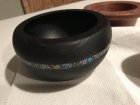
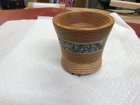
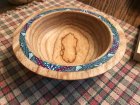
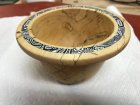
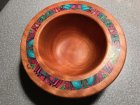
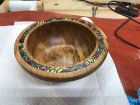
I realized I had not answered one questions above concerning using polymer clay to fill cracks (I assume in bowls). I doubt clay would work well for filling a crack as it has no bonding power on its own. You also must be careful about the glue used. Super glue has some negative effects on polymer clay. Plus you need to cure the clay with heat, so the result after curing with heat may not be favorable for some glues. We have experimented so I'm only guessing (mainly because I don't usually keep the bowls with accidental cracks).
I realized I had not answered one questions above concerning using polymer clay to fill cracks (I assume in bowls). I doubt clay would work well for filling a crack as it has no bonding power on its own. You also must be careful about the glue used. Super glue has some negative effects on polymer clay. Plus you need to cure the clay with heat, so the result after curing with heat may not be favorable for some glues. We have experimented so I'm only guessing (mainly because I don't usually keep the bowls with accidental cracks).
Thanks for the update, I like the rings you inserted into the wood. Crack filling would need additional "locking features" to be curt into the side of the crack, I would guess.


